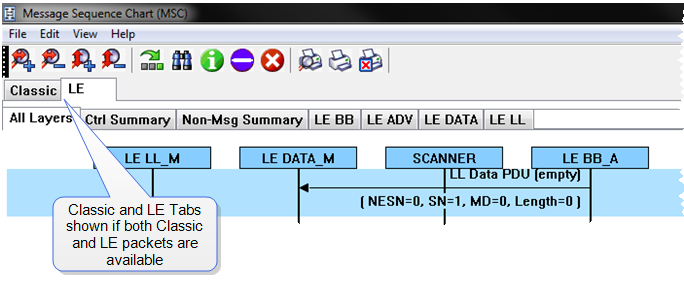Message Sequence Chart (MSC)
The Message Sequence Chart (MSC) displays information about the messages passed between protocol layers. MSC displays a concise overview of a Blutetooth connection, highlighting the essential elements fo the connection. At a glance, you can see the flow of the data including role switches, connection requests, and errors. You can look at all the packets int he capture, or filter by protocol or profile. the MSC is color coded for a clear and easy view of your data.
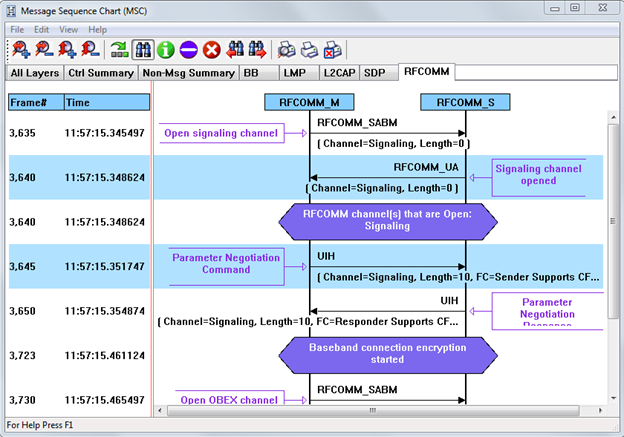
Message Sequence Chart Window
How do I access the chart?
You access the Message Sequence Chart by selecting the icon ![]() or MSC Chart from
the View menu from the Control
window or Frame Display.
or MSC Chart from
the View menu from the Control
window or Frame Display.
What do I see on the dialog?
![]() At the top of the dialog you see four icons that you use to zoom in
and out of the display vertically and horizontally. The same controls are available under the View menu.
At the top of the dialog you see four icons that you use to zoom in
and out of the display vertically and horizontally. The same controls are available under the View menu.
There are three navigation icons also on the toolbar.
 | This takes you to the first Information Frame. |
 | This takes you to first Protocol State Message. |
 | This takes you to the first Error Frame. Click here to learn more about this option. |
If there is both Classic and low energy packets, there will be a Classic and LE tab at the top of the dialog.
Classic and LE tabs
If the Classic tab is selected, you will see Classic protocols. If you select the LE tab, you will see LE Protocols. If there is only Classic or only LE, the Classic and LE tabs will not appear.
![]() Also along the top of the dialog are a series of protocol tabs. The tabs will vary depending on the captured protocols.
Also along the top of the dialog are a series of protocol tabs. The tabs will vary depending on the captured protocols.
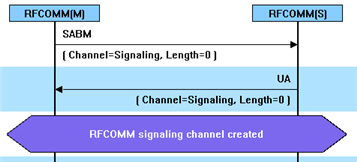 Clicking on a tab displays the messaging between the master and slave
for that protocol. For
example, if you select RFCOMM, you will see the messaging between the
RFCOMM{M} Master, and the RFCOMM{S} Slave.
Clicking on a tab displays the messaging between the master and slave
for that protocol. For
example, if you select RFCOMM, you will see the messaging between the
RFCOMM{M} Master, and the RFCOMM{S} Slave.
The Non-Message Summary tab displays all the non-message items in the data.
The Ctrl Summary tab displays the signaling packets for all layers in one window in the order in which they are received.
The information in the colored boxes displays general information about
the messaging. The same is true for each one of the protocols.
If you want to see the all the messaging in one dialog, you select the All Layers tab.
 When you move the mouse over the message
description you see an expanded tool tip.
When you move the mouse over the message
description you see an expanded tool tip.
If you position the cursor outside of the message box, the tool tip will only display for a few seconds.
If, however, you position the cursor within the tool tip box, the message will remain until you move the cursor out of the box.
Additionally, If you right click on a message description, you will see the select Show all Layers button.
![]() When you select Show
all Layers, the chart will display all the messaging layers.
When you select Show
all Layers, the chart will display all the messaging layers.
The Frame# and Time of the packets are displayed on the left side of the chart.
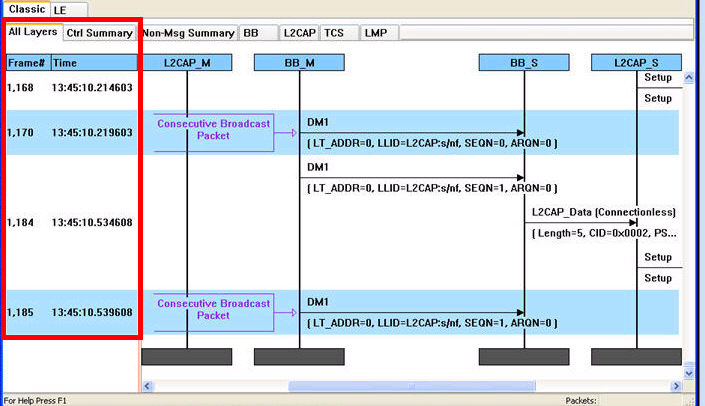
Frame# and Time Display, inside red box.
If you click on the description of the message interaction, the corresponding information is highlighted in Frame Display.

MSC Synchronization with Frame Display
How do I navigate in the dialog?
You can use the navigation arrows at the bottom and the right side of the dialog to move vertically and horizontally. You can also click and hold while moving the pointer within dialog that brings up a directional arrow that you can use to move left/right and up/down.
Ctrl Summary tab
When you select the Ctrl Summary tab you will see a summary of the control and signaling frames in the order that they are received/transmitted from and to devices.

Control and Signaling Frames Summay
The frame numbered is shown, whether the message comes from the Master or Slave, the message Address, the message itself, and the timestamp.
Additionally, the control/signaling packets for each layer are shown in a different background color.

Packet Layers Shown in Different Colors
If you right click within the Ctrl Summary, you can select Show in MSC.

Right-Click in Ctrl Summary to Display Show in MSC
The window then displays the same information, but in the normal MSC view.
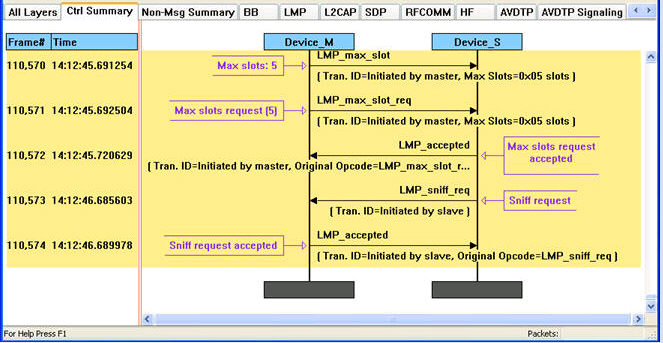
MSC View of Selected Packet from Ctrl Summary
You can return to the text version by using a right click and selecting Show in Text.

Return to Text View Using Right-Click Menu
You can also choose to show:
- Frame # only
- Time only
- Show both Frame# and Time
- Hide both Frame# and Time
